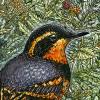

Join BirdNote tomorrow, November 30th!
Illustrator David Sibley and actor H. Jon Benjamin will face off in the bird illustration battle of the century during BirdNote's Year-end Celebration and Auction!
When nesting, most birds lay a predictable number of eggs. Bald Eagles: 2. Bluebirds: 4 to 6. Mallards: 10 to 12. But how do they determine when they have laid the right number? To find out, scientists experimented by going to nests and repeatedly removing eggs soon after they were laid. Some birds replaced them straight away. For example, a House Sparrow laid 50 eggs in a row, while a flicker laid 71 eggs in 73 days. But for other birds, the scientists’ removal of the eggs had no effect at all.
This show brought to you by The Bobolink Foundation.
BirdNote®
How Many Eggs to Lay?
Written by Bob Sundstrom
This is BirdNote.
[Eastern Bluebird song, http://macaulaylibrary.org/audio/107204]
When nesting, most birds lay a roughly predictable number of eggs.
Bald Eagles: 2. Bluebirds: 4 to 6. Mallards: 10 to 12. [Eastern Bluebird song, http://macaulaylibrary.org/audio/107204]
Which leads to an obvious question: How do they determine when they have laid the right number? To find out, scientists experimented by going to nests and repeatedly removing eggs soon after they were laid. Some birds replaced them straight away. For example, a House Sparrow laid 50 in a row, while a flicker laid 71 in 73 days before the removal was halted.
[Northern Flicker song
Birds that do this — keep on laying after eggs are removed — are called indeterminate layers. And for them, it seems that the number of eggs is intimately tied to the brood patch. That's the bare skin on a bird’s underside that transfers body warmth to the eggs during incubation. It's the tactile sensation involved in this process that seems to let the layer know she's reached the ideal number of eggs.
But for some other birds, the scientists’ removing eggs had no effect at all on egg numbers. These are known as determinate layers. And just why these two types of layers exist remains an open question.
For BirdNote, I'm Michael Stein.
Support for BirdNote is provided by the Bobolink Foundation — and generous listeners around the world.
###
Bird sounds provided by The Macaulay Library of Natural Sounds at the Cornell Lab of Ornithology, Ithaca, New York.
BirdNote’s theme music was composed and played by Nancy Rumbel and John Kessler.
Producer: John Kessler
Executive Producer: Dominic Black
© 2015 Tune In to Nature.org June 2018/2023
Narrator: Michael Stein
ID# egg-04-2018-6-7
Primary source: Tim Birkhead’s Bird Sense





